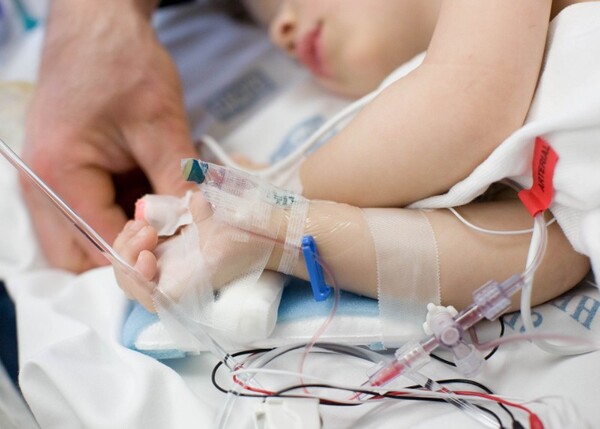
The recent death of a 5-year-old Korean boy -- who could not find a hospital bed for hours in Seoul where medical resources are heavily concentrated -- could be avoidable if the nation heeded calls for installing more pediatric intensive care units (PICUs) and nurturing pediatricians, health experts said.
On the night of Children's Day on May 5, the boy living in Gunja-dong, Seoul, had a fever as high as 40 degrees Celsius and became short of breath. The child was taken to four nearby university hospitals but was unable to receive treatment. There were no beds and no pediatricians available. At the fifth hospital, he was diagnosed with "acute obstructive laryngitis" and went home after treatment without hospitalization. His condition worsened and he died 40 minutes after arriving at a nearby emergency room.
PICUs, which play a pivotal role in improving pediatric critical care mortality, might close one by one because of the declining number of pediatric intensivists. It is rare to find an intern applying for the pediatrics department, let alone pediatric intensive care.
Shortage of PICUs, intensivists in Korea
Korea has only 13 PICUs across the nation -- six in the Seoul metropolitan area, and seven, in the rest of the areas. Eleven are installed in tertiary hospitals and two in general hospitals.
Most recently, Ewha Womans University Mokdong Hospital and Gangnam Severance Hospital halted emergency care for pediatric patients or stopped the service at night.
Not all critically ill children can get into PICUs. Only about 45 percent of them can do so, and the rest 55 percent are admitted to ICUs for adults because of the shortage of beds, according to the medical community.
A 2022 survey on the 13 hospitals with PICUs, conducted by the Korean Society of Pediatric Critical Care Medicine, showed that one intensivist cared for 6.5 critically ill children at a PICU on average in Korea.
The number is far above the global average. Japan has 1.7 seriously ill pediatric patients per intensivist, Switzerland, 1.8, Australia, 2.4, and Indonesia, three, according to KSPCCM.
With little influx of manpower, existing pediatricians are complaining of burnout.
At one pediatric department at a tertiary hospital, professors under the age of 60 are rotating on call due to a lack of manpower.
“When children come to the ICU from hematology-oncology, cardiology, or neurology, they are treated by pediatric intensivists, but in the future, that may be difficult," said Park Seong-jong, a pediatrician at Asan Medical Center. He is the president of the KSPCCM. "The survival rate of children admitted to PICUs is 1.6 times higher than when they are admitted to adult ICUs."
Professor Kim Kyung-won at the Pediatrics Department of Severance Hospital said adult ICUs usually do not receive seriously ill children because of “too much risk.”
“Critically ill pediatric patients are being pushed to the edge, really,” Kim said.
Professor Cho Joong-bum of pediatrics at Asan Medical Center (AMC) said many Korean children were dying at PICUs because of the poor medical system.
“Korean children are living in an underdeveloped country. The nation has failed to make a system to ensure they get the right medical benefit,” Cho said.
Study proves PICUs beneficial to reduce critically ill children’s death rate
Professor Cho at SMC, along with other researchers at Jeonbuk National University and Chungnam National University, found in a joint study that the introduction of PICUs and intensivists contributed to the reduction of seriously ill pediatric patients’ mortality rate in Korea.
The research team analyzed the incidence and mortality trends of 54,843 children younger than 18 years admitted to ICUs from 2012 to 2018 using the Korean National Health Insurance database. They excluded newborn patients and newborn crucially ill patients.
According to the study, the population of the children declined by 17 percent between 2012 and 2018 but the number of pediatric patients with critical illnesses remained constant at 8.5 per 100,000 population.
During the same period, the overall mortality of critically ill children was 4.4 percent. The mortality demonstrated a significant decrease from 5.5 percent in 2012 to 4.1 percent in 2018.
“Mortality among critically ill children improved during the study period, and the improving trend was prominent in children with high treatment requirements,” the research team said. “Varying mortality trends, according to ICU organizations, highlight that advances in medical knowledge should be supported structurally.”
They recently published the study in the Journal of Korean Medical Science.
Related articles
- ‘Medically advanced Korea lags in pediatric intensive care’
- ‘Shortage of anesthesiologists blamed for 4-year-old girl’s tragic death during surgery’
- Pediatric emergency medicine likely to get insurance benefits
- Top pediatric cardiologist laments politics’ ill effects on medical sector
- 'Seoul National University Children's Hospital to expand global outreach of Korea's pediatric care expertise'
- Wandering around ERs? Don’t blame doctors but change the system first.
- Over 700 pediatricians flock to learn lucrative cosmetics biz
- ‘I can’t do this anymore.’ Pediatrician closed clinic due to parental complaints.

